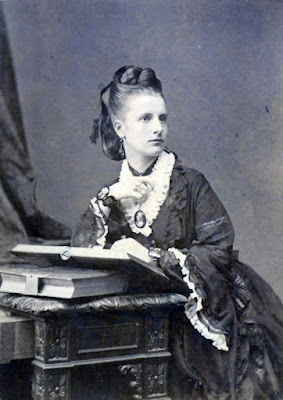Photographer unknown.
There is no information on the back of this cabinet card about the photographer who took this portrait, so I'm forced to rely on the sitter's costume alone in order to date it. She is wearing a dress typical of the "First Bustle" era, which means the photograph was almost certainly taken no later than 1874. From the cut of the sleeves and the style of the bodice, I'm inclined to place it a bit earlier—from around 1870 to 1872.
Incidentally, "First Bustle" period is a bit of a misnomer, because bustles, and bustle-like underpinnings, had been fashionable in various periods before the nineteenth century. The bustle fashions of the 1870s were imitations of the fashionable dress of the 1680s and 1690s, though constructed quite differently. The concept of reviving old fashions did not originate in the twentieth century!
George Fry & Co., Artists & Photographers, 12 Lower Seymour St., Portman Square W
This photograph can be dated with fair accuracy to either 1874 or 1875, as the photographer is listed in the
London Post Office Directory at that address only for these years. Because George Fry & Co was located in the West End of London his sitters were probably mostly well-to-do, and this young lady certainly seems prosperous and fashionably dressed for the mid-1870s.
Stewart & Co., Photographers, Miniature & Portrait Painters, 217 & 219 Bourke St. East, MELBOURNE
Over the years this photograph has come adrift from the card it is pasted on.
The subject of this portrait is wearing fashionable dress for the late 1870s
. This fits with the address on the back of the photograph, as Stewart & Co. expanded their premises from 217 Bourke Street into No. 219 in the New Year of 1877.
Stewart & Co. was located in the theatrical district of nineteenth century Melbourne, and according to some sources, made a specialty of photographing performers. This stylish young woman might be an actress—though alas! who she was and what parts she appeared in are no longer known.


















